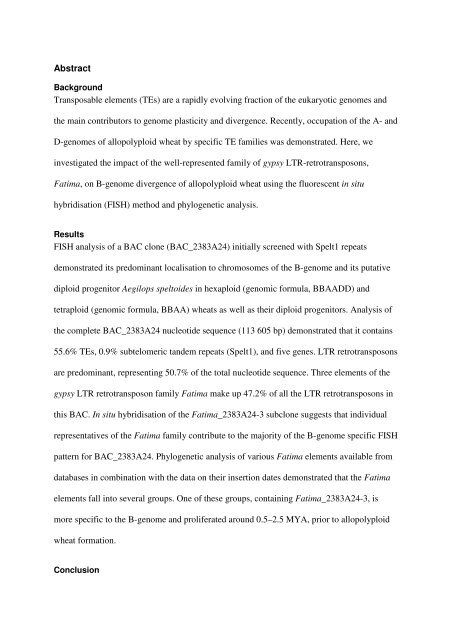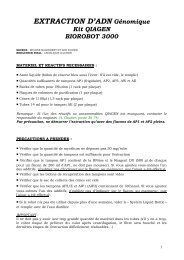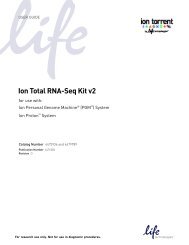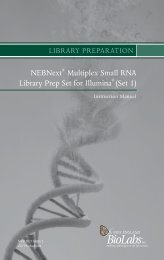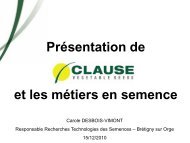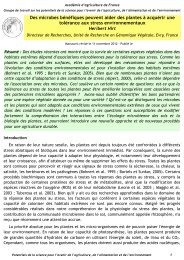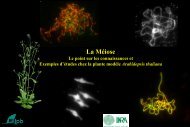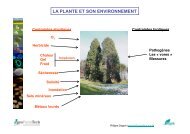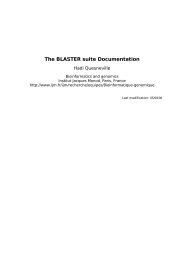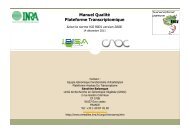The impact of Ty3-gypsy group LTR retrotransposons ... - URGV - Inra
The impact of Ty3-gypsy group LTR retrotransposons ... - URGV - Inra
The impact of Ty3-gypsy group LTR retrotransposons ... - URGV - Inra
You also want an ePaper? Increase the reach of your titles
YUMPU automatically turns print PDFs into web optimized ePapers that Google loves.
Abstract<br />
Background<br />
Transposable elements (TEs) are a rapidly evolving fraction <strong>of</strong> the eukaryotic genomes and<br />
the main contributors to genome plasticity and divergence. Recently, occupation <strong>of</strong> the A- and<br />
D-genomes <strong>of</strong> allopolyploid wheat by specific TE families was demonstrated. Here, we<br />
investigated the <strong>impact</strong> <strong>of</strong> the well-represented family <strong>of</strong> <strong>gypsy</strong> <strong>LTR</strong>-<strong>retrotransposons</strong>,<br />
Fatima, on B-genome divergence <strong>of</strong> allopolyploid wheat using the fluorescent in situ<br />
hybridisation (FISH) method and phylogenetic analysis.<br />
Results<br />
FISH analysis <strong>of</strong> a BAC clone (BAC_2383A24) initially screened with Spelt1 repeats<br />
demonstrated its predominant localisation to chromosomes <strong>of</strong> the B-genome and its putative<br />
diploid progenitor Aegilops speltoides in hexaploid (genomic formula, BBAADD) and<br />
tetraploid (genomic formula, BBAA) wheats as well as their diploid progenitors. Analysis <strong>of</strong><br />
the complete BAC_2383A24 nucleotide sequence (113 605 bp) demonstrated that it contains<br />
55.6% TEs, 0.9% subtelomeric tandem repeats (Spelt1), and five genes. <strong>LTR</strong> <strong>retrotransposons</strong><br />
are predominant, representing 50.7% <strong>of</strong> the total nucleotide sequence. Three elements <strong>of</strong> the<br />
<strong>gypsy</strong> <strong>LTR</strong> retrotransposon family Fatima make up 47.2% <strong>of</strong> all the <strong>LTR</strong> <strong>retrotransposons</strong> in<br />
this BAC. In situ hybridisation <strong>of</strong> the Fatima_2383A24-3 subclone suggests that individual<br />
representatives <strong>of</strong> the Fatima family contribute to the majority <strong>of</strong> the B-genome specific FISH<br />
pattern for BAC_2383A24. Phylogenetic analysis <strong>of</strong> various Fatima elements available from<br />
databases in combination with the data on their insertion dates demonstrated that the Fatima<br />
elements fall into several <strong>group</strong>s. One <strong>of</strong> these <strong>group</strong>s, containing Fatima_2383A24-3, is<br />
more specific to the B-genome and proliferated around 0.5–2.5 MYA, prior to allopolyploid<br />
wheat formation.<br />
Conclusion


